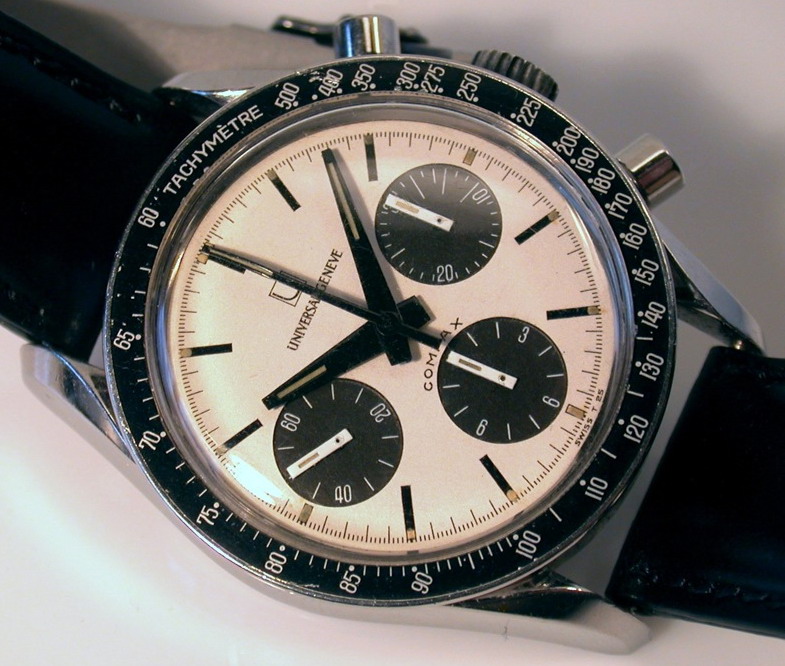| Informational Websites | ChronoMaddox -- the legacy of Chuck Maddox | OnTheDash -- vintage Heuer website | Zowie -- Omega information |
| Discussion Forums | ChronoMaddox Forum | Heuer Forum | Omega Forum |
| Counterfeit Watchers | ChronoTools Forum | ChronoTrader Forum |
|
|
The largest independent, non-commercial, consumer-oriented resource on the Internet for owners, collectors and enthusiasts of fine wristwatches. Online since 1998. | |||||||
|
||||||||
|
||||||||
 |
Vintage Heuer Discussion Forum
The place for discussing 1930-1985 Heuer wristwatches, chronographs and dash-mounted timepieces. Online since May 2003. | ||||||
| |||||||
| |||||||
Lou:
Of the line-up that I posted yesterday, can you tell me which are the V72 powered guys? I assume that these came after the supply of in-house movements dried up?
Also, correct to assume that the squared needles / hands on the chronograph recorders are "later"? Any idea how late?
Thanks,
Jeff



++++++++++++++++++++++++++++
: and I can no more summarize UG in one post than you could
: Heuer...but I'll start if other enthusiasts chime in.
: It's a vast topic because UG was a multifaceted company with many
: achievements to its credit. From the 1920s to the 1960s it was
: perhaps the premier house for complicated chronographs, and one
: of the two or three most respected chronograph
: manufactures. Late in that period it introduced its
: micro-rotor automatic movements and the Polerouter line which
: became another great pillar of the manufacture.
: Since we are where we are, let's stick to the chronographs. UG
: claims to have introduced the worlds first wristwatch
: chronograph in 1917, the world's first wristwatch chronograph
: with two pushers in 1932, and the world's first chronograph with
: three counters in 1933. They based their chronographs on a
: series of in house movements (in fact supplied by Martel under
: exclusive contract) that were more or less scaled versions of
: the same basic ebauche. The model lineup was dynamic, but in
: their period of greatest glory - say 1940 to the 1960s - it ran
: as follows:
: Uni-Compax: two-register chronograph
: Compax: three register chronograph
: Aero-Compax: three register chronograph with a fourth
: "reminder" subdial consisting of a twelve hour clock
: face set from a left sided crown
: Dato-Compax: three register chronograph plus fourth subdial with
: pointer date
: Tri-Compax: three register chronograph with date, day-month and
: moonphase.
: The Compax you show in your post is actually a late model, driven
: by a Valjoux 72. Why? Because Martel had been acquired by Zenith
: in 1960, and Zenith cut off the supply of chrono movements to
: UG. Incidentally, in buying Martel, Zenith also acquired the
: expertise that gave birth to El Primero nine years later. That's
: a separate story, but the interrelationships of these legendary
: companies are interesting to me and explain how Zenith,
: historically NOT a chronograph house, could have produced one of
: the greatest chronograph movements ever.
: Below, I have reproduced a post on the Tri-Compax I made in another
: forum - pardon the redundancies. All you UG enthusiasts chime
: in!
: The Tri-Compax is a wristwatch with three complications -
: chronograph, complete calendar and moonphase - hence the name.
: It is a common and widely held misconception that Tri-Compax
: refers to the three dial layout on many chronographs. The irony
: of course is that the real Tri-Compax has four subdials. For UG,
: a three dial chronograph, because it only had the chronograph
: complication, was simply a 'Compax.'
:
: 
:
: 
: The Tri-Compax was UG's most complicated chronograph and flagship
: model, introduced at the Basel watch fair in 1944 for the
: company's 50th anniversary. It remained so into the 1970s, when
: UG hit rocky times as did every other manufacture with the
: advent of quartz. An additional short run was produced in the
: mid 1980s with leftover ebauches. It is powered by one of UG's
: two core engines, the cal. 281, an in house caliber developed
: under the direction of CEO Raoul Perret, the son of the original
: founder.
:
: 
:
: 
: The Tri-Compax exists in dozens of versions. UG reserved 100
: numbers to code the different models, and ended up having to add
: suffixes to describe sub-variations, just to give you an idea of
: the variety.
: So for your consideration, my two examples, both late versions with
: waterproof pushers and twisted lug cases. Although there is a
: design similarity with teh Speedmaster cases, these are smaller
: at 35mm
: ref. 222100-1, produced in 1960 according to the serial number
:
: 
: ref. 881101/02, produced in 1966. The pulsometer bezel is as
: unusual for a UG as it is for a Speedmaster
:
: 
: Thanks for reading this far!
| Chronocentric and zOwie site design and contents (c) Copyright 1998-2005, Derek Ziglar; Copyright 2005-2008, Jeffrey M. Stein. All rights reserved. Use of this web site constitutes acceptance of the terms of use. | CONTACT | TERMS OF USE | TRANSLATE |